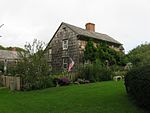Jones Road Historic District
Historic districts in Suffolk County, New YorkHistoric districts on the National Register of Historic Places in New York (state)NRHP infobox with nocatNational Register of Historic Places in Suffolk County, New YorkSuffolk County, New York Registered Historic Place stubs ... and 1 more
Use mdy dates from August 2023

Jones Road Historic District is a national historic district located at East Hampton, New York in Suffolk County, New York. The district includes 19 contributing buildings; 10 principal buildings and nine outbuildings. It is a rural enclave of residences built between about 1750 and 1921.It was added to the National Register of Historic Places in 1988.
Excerpt from the Wikipedia article Jones Road Historic District (License: CC BY-SA 3.0, Authors, Images).Jones Road Historic District
Jones Road,
Geographical coordinates (GPS) Address Nearby Places Show on map
Geographical coordinates (GPS)
| Latitude | Longitude |
|---|---|
| N 40.941944444444 ° | E -72.211666666667 ° |
Address
Jones Road 27
11937
New York, United States
Open on Google Maps








